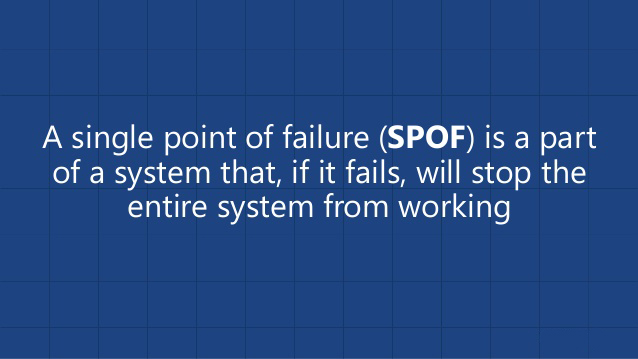Your responsibility as a leader is to identify the key people in your business and plan for their unexpected disappearance. In fact, I’d urge you to understand that ALL your staff are key and that you shouldn’t have ANY key individuals at all…
Leading an IT business for 16 years caused me to hear the term SPOF on many occasions. SPOF – Single Point of Failure.
Our technical boffins would speak in hushed tones of avoiding designs with single functions that would, if they fail, take down the entire system.
Kind of why aircrafts are designed to have multiple systems in critical situations, so if one system fails, another takes over and the aircraft stays in the sky – they call it “redundancy”. A must if you’re on your way to Florida!
It seems we consider such situations when building systems, machines, buildings and transport… but not so much when the system involves people.
Of course, SPOF’s appear in businesses of every kind, not just IT companies.
I meet business owners from different sectors all over the world. And, no matter what business they’re in, way too many times I’ve heard them say things like, “I personally check the quality of every single one of the products we make”, or “I sign every cheque”, or “I ensure everything decision to buy something goes through me first”.
And the number of times I’ve heard, “wouldn’t have happened if I wasn’t there”?
Crazy thing is, they always seem to say these things with an air of pride.
If the diagram below looks anything like the structure of your organisation then you may have SPOF issues too?
If so, don’t feel too bad, it’s exactly what I used to do in my business.
Of course, the net result is that the Leader becomes the Single Point of Failure in the organisational system and without them, the business would, at least for a time, come to disastrous halt.
The thing is, it’s only in hindsight do you become aware of the serious consequences of such situations.
- The process slows down, almost to a standstill at times
- The SPOF ends up working longer hours or
- Important deadlines are missed or tasks fail to get done at all
- Staff end up happy to do as little as possible
I used to justify my actions by using some or all of these “reasons”;
- No-one can do it as good or as quick as I can
- It will take me 10 minutes to do it and 30 minutes to show someone else how to do it
- I’m going to get the “shit” if it goes wrong anyway
- I want to be the hero
The problem with this of course, is that I simply created an unsustainable risk and the longer the single point of failure existed, the more comfortable everyone became with it.
Hardly great leadership really… as Lao-Tzu once said, “A leader is best when people barely know he exists, when his work is done, his aim fulfilled, they will say: we did it ourselves.”
Trouble is, really good leadership is barely recognised, rarely rewarded and often punished as the business owner fails to see its strength.
I had a great friend who always seemed to be “surplus to requirements” everywhere he worked. I asked him once, why he kept moving jobs. He said, “Dave, it’s not by choice. Each time I develop the team around me to work efficiently without me needing to be there, the owners think they don’t need me anymore and let me go!”
So how can you avoid “single point of failure” situations in your team?
One of the often overlooked tasks of any leader is to plan his succession and ensure his team continues to work even if it loses a key member. Buried in the “business as usual” stuff we fail to make the team resilient and disaster- proof.
So how do you fix this situation?
Here’s the Renegade 4 Step Process for SPOF Removal…
Step 1 – Identify single-point-of- failure team members
SPOF’s are not necessarily those in senior positions or the ones with fancy titles, look for those who are key to the success of your team and difficult to replace.
Ask yourself who in your business:
- Holds unique knowledge, whether it’s institutional, technical, proprietary or maybe they just know lots about your customers?
- Has a unique skill-set? The Salesman, The Go-To Guy, The Coach/Mentor
- Provides a unique function that binds the team together? The Leader, The Social Glue that keeps the team together and makes the work fun
Look for situations where one or two team members have become the experts during the implementation phase but then quickly move onto new tasks or roles once the project is completed. Whether by accident or design, the organisation is then left with one person as the best person to speak to and after a few months they actually become the ONLY person anyone can speak to on the topic.
Be aware of the “deliberate SPOF”. The person using the ‘knowledge is power’ principle. ‘I can write my own pay cheque’ and ‘they can’t re me’ are two beliefs these people hold and do everything to exploit.
Low frequency processes can be particularly vulnerable to being taken over by SPOFs. Payroll can be a typical example, a monthly process managed exclusively by one person without even the back up of a documented procedure. Imagine telling your sales- team you can’t pay their commission this month because Dave is off sick!
While these issues are different the risks to your business are the same: ‘if the SPOF falls under a bus tonight, what are we going to do?’
Here are 3 clear signs of SPOF’s in your business;
- People who avoid documenting their procedures or information
- People reluctant to take holidays
- People who insist on being on call 24/7
If you don’t know what they are doing, maybe it’s because they don’t want you to…
Let me give you an example of an extreme (and very deliberate) SPOF situation in one of our customers – I can’t say which for obvious reasons.
So, this customer operates hundreds of premises across the UK. They have many statutory compliance requirements in those premises and the records they keep to prove they are doing these things are kept on site… or so they thought.
As our staff inspected their premises we struggled to find these documents and reported it to them. It seems they were ALL found in a steel container that was locked, bolted and had two padlocks. The holder of the keys for these padlocks was identified and when asked, his reasons for moving them to one location was to ensure “nothing was lost”. But worryingly for me, no-one else in the organisation had any idea this had happened and if he’d been run over by a bus would never have found them again.
For some reason, we’re all too often either blind to the risk or reluctant to do something about people SPOFs, mostly out of fear of upsetting the individual.
But this simply gives the SPOF more power and the longer the situation persists the greater the risk to your business.
Step 2 – Mitigate the Risk
Once you identify the SPOF’s, consider what would happen if they didn’t show up for work. What would the team look like without that particular person and what unique knowledge, skill or function you would have to replace? Consider the short and long- term impact on the team, atmosphere, product, customers, daily operations and the potential growth of the business?
Then look at the rest of the team and consider who might be capable of providing cover for that particular knowledge, skill or function.
If no-one is capable of being trained to
replace the SPOF you should consider recruiting relevant experience quickly.
- Your SPOFs are probably staring you in the face – if you know your business well you’ll be able to identify who they are.
- Do not be held to ransom by them, what if they resigned tomorrow?
- Deal with it now. Take action before it’s too late.
- De-personalise the situation, explain it’s about your process not the individual.
Step 3 – Plan, Do, Check, Act
Create a development plan for the distribution of this vital skill or knowledge. Talk with your SPOF and help them understand the risks to the business and ensure they share this skill or knowledge with their colleagues. As with any developmental plan you will need to regularly follow- up on the progress of the knowledge transfer or skill enhancement. Act on any procrastination quickly, remember, this is critical to the success of your business.
Step 4 – Regularly Review
Review your plan regularly and consider it when assigning new responsibilities to someone or reorganising the team. Ensure that with each new change you check for any new single-point- of-failure situations and remove them immediately.
Constantly give people a chance to learn new skills or get knowledge they need to act as a back-up for your key people.
Don’t make the same mistake I made by constantly assigning our key staff on any critical or new projects because it only creates a greater dependency on them, limits the growth of the rest of the team and increases the risk for the business.
Do the exercise on a regular basis. Maybe every month especially if the organisation grows or shrinks.
When you get to a point that the list of key people gets down to zero it means you have enough resilience in the business to survive anything – even someone taking a day off.





